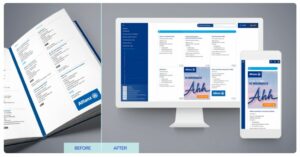It is now easier than ever to include online advertising in your publications and monetise your documents. Livebook lets you sell ad space in your online publication!
Covering the basics – what is Livebook?
If you don’t know what a Livebook is, check out the article Introducing Livebook, a new product by MMR.
In essence, it is an online publishing solution that allows you to format and create large scale documents online, edit them as often as required, and then convert the whole thing into a print-ready PDF.
Livebook is a much more modern and flexible alternative for your usual offline editable documents like PDFs. Livebook is fully interactive, rich in media, always up to date, and fully responsive. Since Livebook is a website, living in an online environment, we have made it possible to include ads in your publication.
MMR is a boutique agency in South Melbourne. The concept was born while problem-solving for a client. Once we realised that this type of functionality did not yet exist, we created Livebook.
Here are some examples of the types of documents that are optimal for Livebook development:
- Policy Documents
- Instruction Manuals
- Directories
- Rule Books
- Handbooks
- Yearbooks
- Annual Reports
- Activity Books
- Magazines and much more
Should you include online advertising on your Livebook publication?
The Ad Manager is an entirely optional component for a Livebook; you can choose to create one with or without it.
The Ad Manager add-on allows you to monetise your document(s) by selling ad space to other businesses. If you receive a lot of traffic on your Livebook website, it may be a suitable environment for using this space for some online advertising.
After all, your traffic will be a crucial selling point for selling ad space.
We suggest learning about how to increase your website traffic by improving your SEO (Search Engine Optimization) and how to put a healthy Marketing strategy in place.
Livebook is compatible with Google Analytics, so you can have a clear understanding of how much traffic you are getting and who your audience is.
Keep these findings in mind when reaching out to companies who to are best-suited and would benefit from the ad space you are offering for online advertising.
How to manage online advertising in Livebook?
There are two different section types that Livebook can consist of – HTML sections (your standard text and image content) and listings (where you can upload data via Excel spreadsheet).
Most documents are quite straight forward, and will not require the inclusion of listings. In this case, you can have your standard Header, Footer or MREC types of ads.
For the listings sections, you can create ads that sit directly within the listing. We have created the option of including premium and standard ad spaces.
In this example – standard ads are the equivalent of one listing in terms of display size, whereas Premium ads can take up the space of a full row of listings (usually 3, however, this can vary depending on the design).
See the standard ad in a listing on the image below as a visual reference.

The Ad Manager feature will exist as a separate module in the back end of your Livebook site, where you log in and access the CMS. In the Ad Manager, you can be in full control of all your online advertising; you can turn ads off and on, upload, edit and delete them. You can also manage details around the location, repetition and the display lengths of the ads.
Regardless of the location, currently, you can choose between static and carousel ads.
As you can see, Ad Manager allows you to get creative with how you decide to include online advertising in your project. If you don’t have listings in your project, you can create a space in the content for the ads. For example, they can be stuck to the content and scroll off the screen as you move along, or they can permanently stay in the footer or header.
How to set up payments for your Livebook advertisements?
As well as the other Livebook aspects, there are also different options for payments.
The first solution is to charge a monthly rate for displaying certain ads in specific locations. You can offer different options at different prices, as some spots are more premium and get more spotlight than others. In this scenario, what you charge is entirely up to you. We would recommend conducting some market research on the average cost for online advertising and different ad spaces and keep it in line with the overall trends.
Another option is to set up a slightly more sophisticated “pay per click” system. In this case, the users pay according to the impressions that they have received on their ads. Advertisers purchase credit from you, which gets drawn from upon each ad click. When using this method, the ad will run until the user’s credit has been exhausted.
As an extra module, it is possible to include a payment portal for ad space purchases, so you won’t need to worry about sending invoices manually.
In both cases, analytics can be applied, that can report impressions and click through rates. We can also use time-based filters which will allow you to see the reactions for a given date range.
Livebook is just like any other website, and what is possible on any other website, is possible on Livebook.



